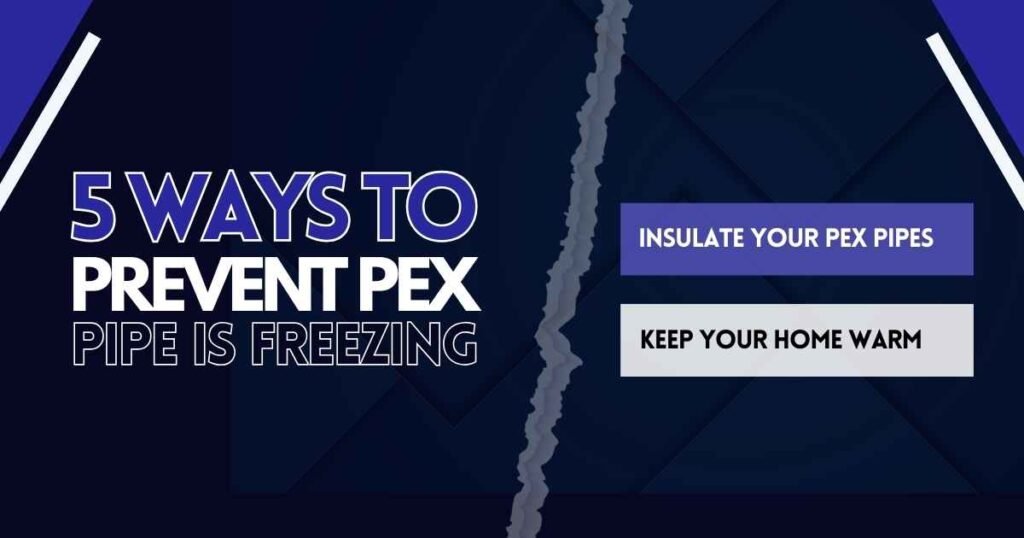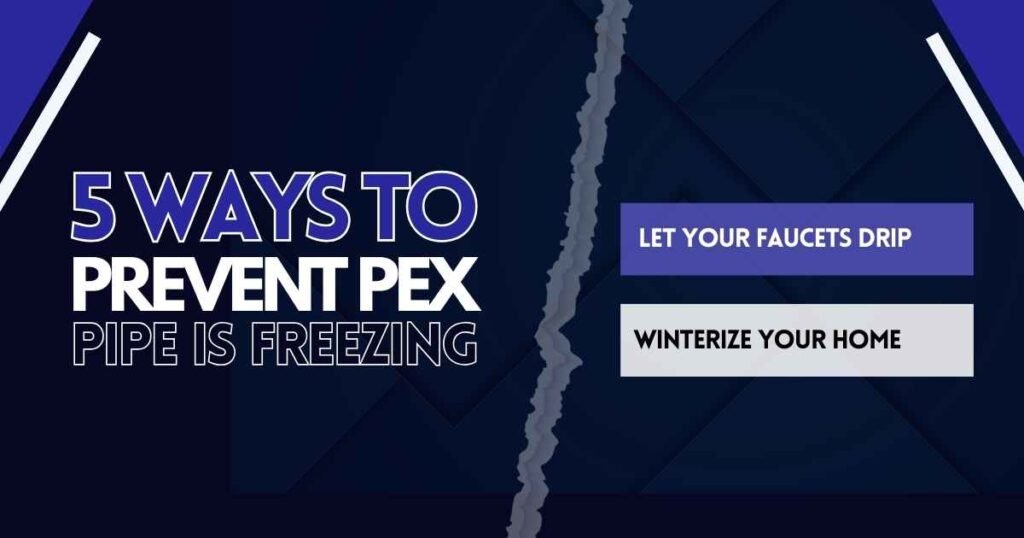Living in cold areas can be enjoyable, especially during the holiday season. But cold weather isn’t always friendly to plumbing systems.
Freezing temperatures can cause pipes to burst, leading to big problems right in the middle of your celebrations. This is a common issue for all types of pipes during winter, including PEX pipes. Fortunately, there are effective ways to protect your PEX pipes and prevent expensive repairs.
What Is PEX Piping?
PEX pipes are flexible plastic tubing made from cross-linked polyethylene, widely used in home water systems. They’re affordable, easy to install, and highly durable, making them a favorite among plumbers and homeowners. PEX is resistant to corrosion and scale buildup, unlike metal pipes, which means it lasts longer with less maintenance.
Its flexibility makes it ideal for tricky installations, like tight spaces or homes with unusual layouts. PEX is also able to expand slightly, helping it resist damage during freezing temperatures. Because of these benefits, many homeowners choose to replace older copper or galvanized steel pipes with PEX for a modern, cost-effective plumbing solution.
How Can You Tell if a PEX Pipe Is Frozen?

Since PEX pipes are made of plastic, it can be harder to spot when they’re frozen compared to metal pipes. Still, there are a few signs to look out for:
1. Frost on the Pipes
If your PEX pipes are freezing, you might notice a thin layer of frost on their surface. This often happens in areas with little to no insulation, like garages, crawl spaces, or basements. Look closely at exposed pipes or those running along exterior walls, as these are more vulnerable to cold temperatures. Frost is an early warning sign that your pipes are at risk of freezing completely.
2. Weak Water Flow
If you turn on the faucet and only a small amount of water comes out—or nothing at all—it could be a sign of PEX freezing. The water inside the pipe may have turned to ice, and it might even feel unusually cold. Frozen pipes can block water flow, and if not thawed quickly, they can burst. This can also lead to hidden leaks that cause bigger issues like mold, foundation damage, or wood rot.
3. Leaks or Water Damage
While PEX pipes are more flexible and less likely to burst than metal pipes, they can still crack under extreme pressure from frozen water. When this happens, you might notice water leaking under sinks, in cabinets, or on floors near the pipes. Sometimes, you’ll hear dripping water even if you can’t see the leak right away.
5 Ways to Prevent PEX Pipes from Freezing

1. Insulate Your PEX Pipes
If you live in a cold area, insulating your pipes is important, especially where they’re exposed to the cold, like basements, attics, or crawl spaces. Even in milder climates, insulation can save you from costly damage caused by an unexpected freeze.
For example, if you have PEX pipes running along your garage wall, wrapping them with foam pipe insulation will help keep them from freezing. Foam is flexible and easy to use, making it perfect for PEX pipes that bend around corners.
Skipping insulation isn’t just risky—it might also break plumbing codes in your area. For instance, some states require exposed pipes to be insulated to avoid issues during winter. Check your local guidelines to make sure you’re compliant.
2. Keep Your Home Warm
When outdoor temperatures drop below 20°F, your pipes are at risk of freezing. To prevent this, maintain an indoor temperature of at least 55°F, even if you’re not home.
For example, if you’re heading out for a weekend trip in the winter, set your thermostat to 55°F before leaving. It might increase your heating bill a bit, but it’s far cheaper than fixing burst pipes or water damage.

3. Let Your Faucets Drip
Leaving faucets slightly open allows water to keep moving through the pipes, reducing the risk of freezing. A small trickle can prevent pressure buildup, which is often what causes pipes to burst.
For example, on a particularly cold night, open your kitchen and bathroom faucets slightly so water drips steadily. If you have a two-handle faucet, turn on both the hot and cold water. As strange as it sounds, hot water can freeze faster than cold, so keeping both flowing helps protect the pipes.
4. Winterize Your Home
Winterizing your home is especially useful for vacation homes, rental properties, or houses that won’t be used during the winter.
For example, before leaving a cabin for the season, seal cracks around doors and windows to keep the cold out, clean gutters to prevent ice buildup, and add insulation to exposed pipes. Don’t forget to turn off the water supply and drain the pipes completely.
If you’re unsure how to do this, a plumber can help. They can also check your boiler or furnace to ensure everything is in working order before the freeze sets in.
5. Route PEX Pipes Through Interior Spaces
When designing a new home or upgrading your plumbing, make sure PEX pipes are routed through heated spaces inside the home. Pipes running through exterior walls, garages, or crawl spaces are more likely to freeze.
For example, instead of running a water line through an unheated garage, route it through an interior hallway wall. If you already have pipes in unheated areas, consult a plumber to reroute them. While this may cost $100–$500 per hour, it’s a good investment compared to repairing water damage, which can exceed $6,000.
Running pipes in warmer spaces also makes them less prone to damage and keeps your plumbing system working efficiently during the cold months.
Act Now, Avoid Repairs
“An ounce of prevention is worth a pound of cure.” — Benjamin Franklin
Protecting your PEX pipes now prevents costly problems in the future. Winter can be tough on plumbing, but with a little effort, you can avoid the stress and expense of burst pipes. Preparing now, you’re not just keeping your pipes safe—you’re protecting your home, your peace of mind, and your wallet.
Don’t wait for winter to cause trouble! Let Vegas Plumbing Pros help protect your pipes and your home. Contact us today for expert advice and services to keep your plumbing safe and stress-free all season long.
FAQs
How do you insulate PEX pipe?
Reflective Foil Insulation: This type of insulation is a great choice for PEX pipes in areas with extreme temperature changes, like attics, basements, or crawl spaces. It works by reflecting heat back into hot water pipes, helping to keep water hot for longer. At the same time, it prevents cold water pipes from absorbing heat, which helps keep cold water cool.
What Happens When Pex Pipe Freezes?
When a PEX pipe freezes, the water inside turns to ice and expands. This can block water flow and create extra pressure inside the pipe. While PEX is more flexible than metal pipes and less likely to crack, it can still burst if the pressure becomes too much. Frozen pipes can also lead to hidden leaks, which might cause water damage, mold, or other problems in your home.
How To Unfreeze Pex Water Pipes?
To unfreeze PEX pipes, open the faucet to relieve pressure and gently warm the pipe with a hair dryer or heating pad. Avoid open flames. If the pipe is hard to reach, use a space heater or raise your home’s temperature. Keep the faucet open until water flows fully. Call a plumber if the pipe stays frozen or has burst.
How To Thaw Pex Water Lines?
If your PEX pipes are frozen, start by turning off the main water supply. Open the faucets connected to the frozen pipes and let them drain. Use a hair dryer held a few inches away to warm the frozen section, checking regularly to see if the ice has melted. If you see a crack, call a plumber to avoid bigger problems and costly repairs.



